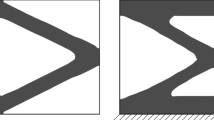Abstract
A support structure design technique for additive manufacturing (AM) is proposed that minimizes the deformation while using the least amount of support material, minimizes the time required to add the supports, and designs supports that are easily removed. This study presents a repulsion index (RI), which satisfies the easy removal requirement and minimizes the number of artifacts left on the specimen surface, and a weighting function, which quantifies the cost incurred by the time taken to build the supports. A multi-objective topological optimization based on the simple isotropic material with penalization method, continuous approximation of material distribution, and method of moving asymptotes is formulated that includes the proposed RI and cost formulation. Numerical simulations demonstrate that rational support layouts can be determined with the proposed cost-based formulation in the topological optimization, allowing designers to find design solutions with a compromise between specimen surface profile error and support structure costs.
















Similar content being viewed by others
References
AM Sub-Platform (2014) Additive manufacturing: strategic research agenda (release 2014). European technology Sub-platform in Additive manufacturing. http://www.rm-platform.com/. Accessed 31 June 2016
Bendsøe MP, Sigmund O (2004) Topology optimization - theory, methods, and applications. Springer, Verlag Berlin Heidelberg
Bendsøe MP, Sigmund O (2007) Topology optimization. In: Arora SJ (ed) Optimization of structural and mechanical systems. World Scientific Publishing Co Pte Ltd, 161–194. doi: 10.1142/9789812779670_0006
Buhl T (2002) Simultaneous topology optimization of structure and supports. Struct Multidisc Optim 23:336–346. doi:10.1007/s00158-002-0194-2
Gaynor AT, Guest JK (2016) Topology optimization considering overhang constraints: Eliminating sacrificial support material in additive manufacturing through design. Struct Multidisc Optim 54:1157–1172. doi:10.1007/s00158-016-1551-x
Gibson I, Rosen D, Stucker B (2015) Additive Manufacturing Technologies. Springer, New York
Gilbert EN, Pollak HO (1968) Steiner minimal trees. SIAM J Appl Math 16(1):1–29
Hu K, Jin S, Wang CC (2015) Support slimming for single material based additive manufacturing. Comput Aided Des 65:1–10
Huang Y, Leu MC, Mazumder J, Donmez A (2015) Additive Manufacturing: Current State, Future Potential, Gaps and Needs, and Recommendations. ASME J Manuf Sci Eng 137(1):014001. doi:10.1115/1.4028725
Hussein A, Hao L, Yan C, Everson R, Young P (2013) Advanced lattice support structures for metal additive manufacturing. J Mater Process Technol 213(7):1019–1026
Hwang FK, Richards DS (1992) Steiner tree problems. Networks 22(1):55–89
Langelaar M (2016) Topology optimization for additive manufacturing with controllable support structure costs. ECCOMAS Congress 2016, Crete Island, Greece, 5–10
Langelaar M (2017) An additive manufacturing filter for topology optimization of print-ready designs. Struct Multidisc Optim 55:871–883. doi:10.1007/s00158-016-1522-2
Leary M, Merli L, Torti F, Mazur M, Brandt M (2014) Optimal topology for additive manufacture: A method for enabling additive manufacture of support-free optimal structures. Mater Design 63:678–690
Matsui K, Terada K (2004) Continuous approximation of material distribution for topology optimization. Int J Numer Meth Eng 59(14):1925–1944. doi:10.1002/ nme.945
Mirzendehdel AM, Suresh K (2016) Support structure constrained topology optimization for additive manufacturing. Comput Aided Des 81:1–13
Strano G, Hao L, Everson RM, Evans KE (2013) A new approach to the design and optimisation of support structures in additive manufacturing. Int J Adv Manuf Technol 66:1247–1254. doi:10.1007/s00170-012-4403-x
Svanberg K (1987) The method of moving asymptotes - a new method for structural optimization. Int J Numer Methods Eng 24(2):359–373
Svanberg K (2007) On a globally convergent version of MMA. In: Proceedings of the Seventh World Congress of Structural and Multidisciplinary Optimization, Seoul, Korea
Vanek J, Galicia JAG, Benes B (2014) Clever support: efficient support structure generation for digital fabrication. Eurographics Symposium on Geometry Processing 2014, 33:117–125. doi: 10.1111/cgf.12437
Zuo KT, Chen LP, Zhang YQ, Yang J (2005) A hybrid topology optimization algorithm for structural design. Eng Optim 37(8):849–866
Author information
Authors and Affiliations
Corresponding author
Appendix
Appendix
The sensitivity of the RI used in gradient-based optimizations such as MMA is expressed as follows:
where
and
where the subscript e1 , e2 and e3 are the subscript 1 , 2 and 3 of ρ in Fig. 3, H = 2 and Π is the product of a sequence.
The sensitivity of w te (ρ e ) with respect to the density of each element is given by
where
and
Rights and permissions
About this article
Cite this article
Kuo, YH., Cheng, CC., Lin, YS. et al. Support structure design in additive manufacturing based on topology optimization. Struct Multidisc Optim 57, 183–195 (2018). https://doi.org/10.1007/s00158-017-1743-z
Received:
Revised:
Accepted:
Published:
Issue Date:
DOI: https://doi.org/10.1007/s00158-017-1743-z




